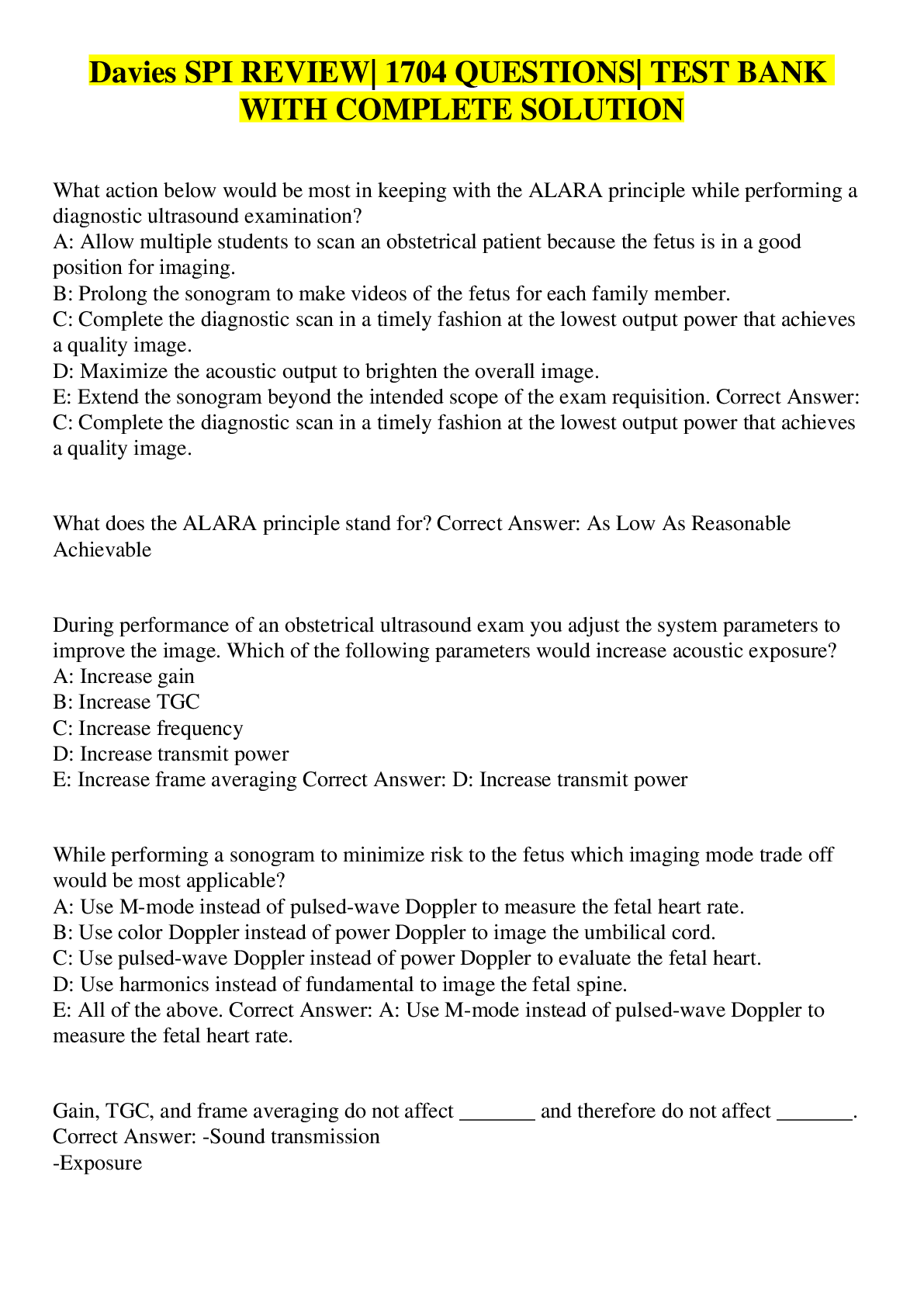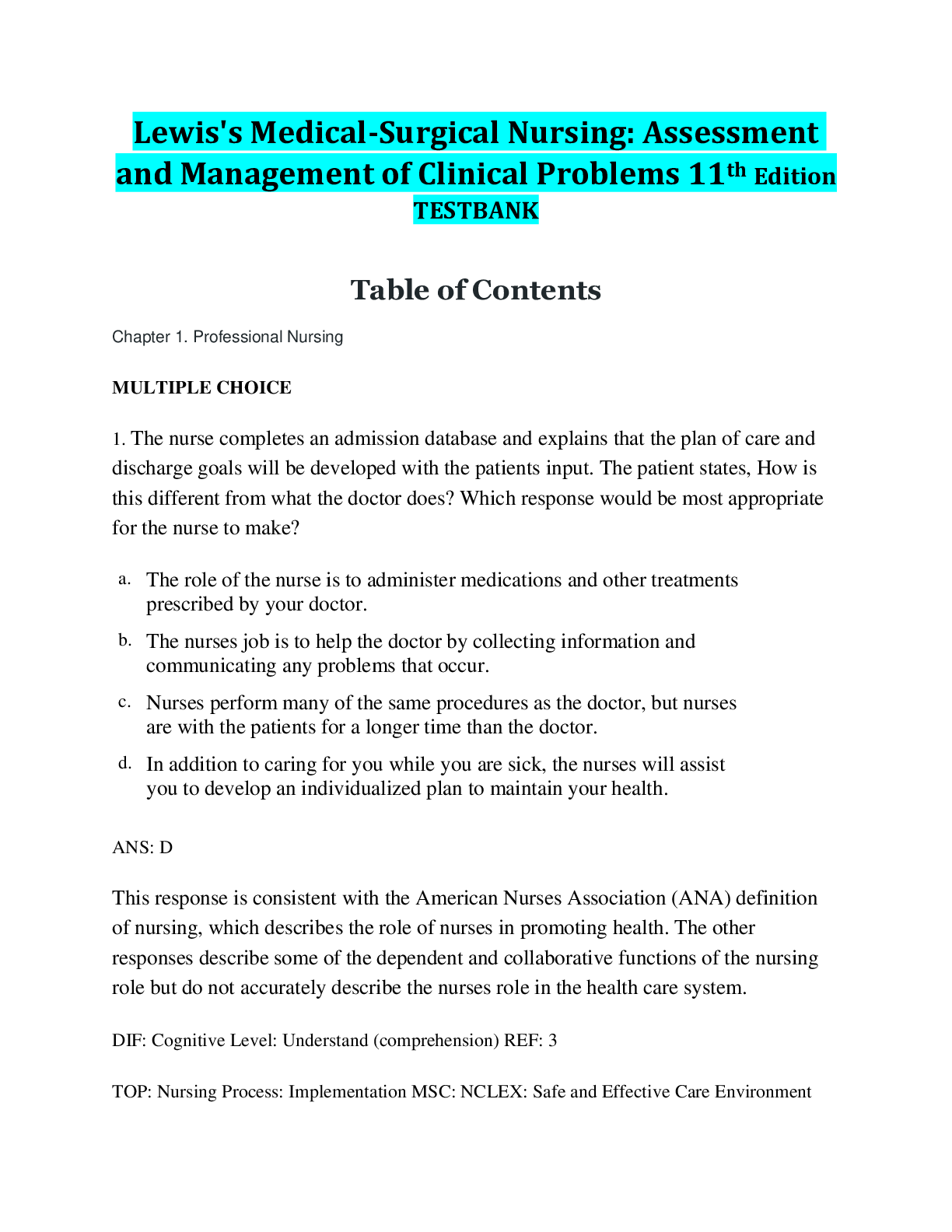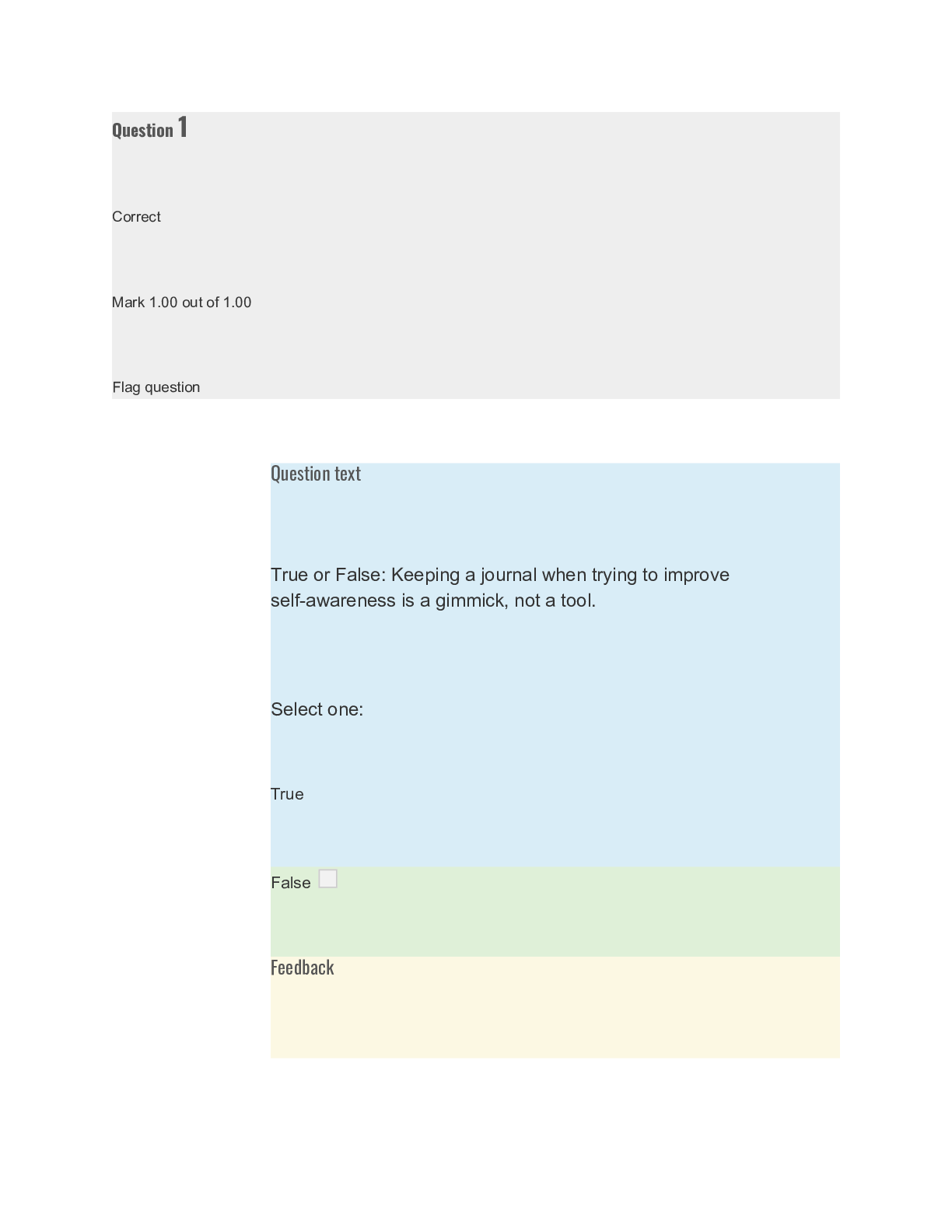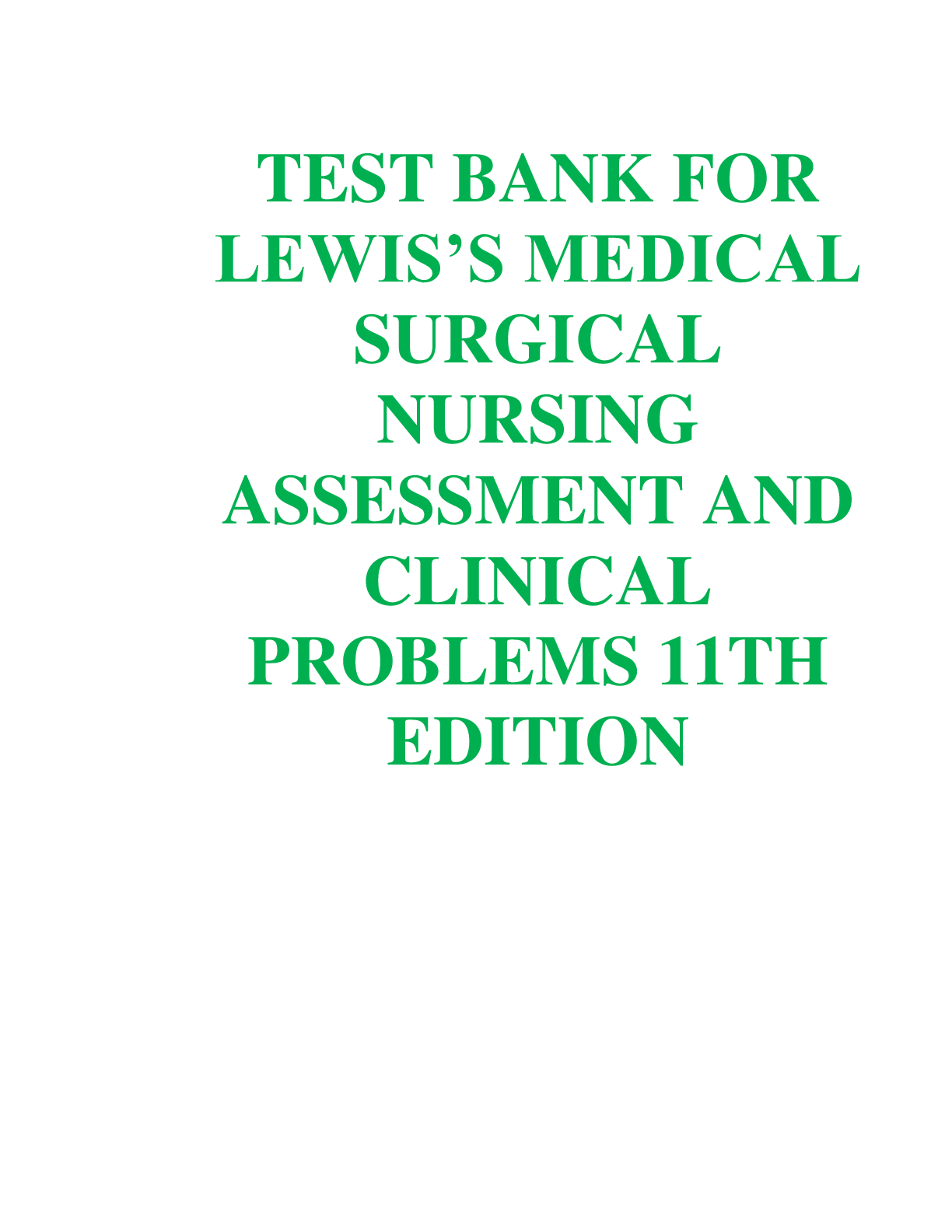*NURSING > TEST BANK > TEST BANK LEWIS'S MEDICAL SURGICAL NURSING 11TH EDITION HARDING Test Bank with Complete Questions a (All)
TEST BANK LEWIS'S MEDICAL SURGICAL NURSING 11TH EDITION HARDING Test Bank with Complete Questions and Solutions 695 PAGES
Document Content and Description Below
TEST BANK LEWIS'S MEDICAL SURGICAL NURSING 11TH EDITION HARDING Test Bank with Complete Questions and Solutions 695 PAGES. To clarify, this is the test bank, not the textbook. You get immediate acces... s to download your test bank. You will receive a complete test bank; in other words, all chapters will be there. Test banks come in PDF format; therefore, you do not need specialized software to open them. PREVIEW.... Chapter 01: Professional Nursing Harding: Lewis’s Medical-Surgical Nursing, 11th Edition MULTIPLE CHOICE 1. The nurse completes an admission database and explains that the plan of care and discharge goals will be developed with the patient’s input. The patient asks, “How is this different from what the doctor does?” Which response would be most appropriate for the nurse to make? a. “The role of the nurse is to administer medications and other treatments prescribed by your doctor.” b. “In addition to caring for you while you are sick, the nurses will help you plan to maintain your health.” c. “The nurse’s job is to help the doctor by collecting information and communicating any problems that occur.” d. “Nurses perform many of the same procedures as the doctor, but nurses are with the patients for a longer time than the doctor.” ANS: B The American Nurses Association (ANA) definition of nursing describes the role of nurses in promoting health. The other responses describe dependent and collaborative functions of the nursing role but do not accurately describe the nurse’s unique role in the health care system. DIF: Cognitive Level: Analyze (analysis) TOP: Nursing Process: Implementation MSC: NCLEX: Safe and Effective Care Environment 2. The nurse describes to a student nurse how to use evidence-based practice (EBP) when caring for patients. Which statement by the nurse accurately describes the use of EBP? a. “Inferences from all published articles are used as a guide.” b. “Patient care is based on clinical judgment, experience, and traditions.” c. “Data are analyzed later to show that the patient outcomes are consistently met.” d. “Recommendations are based on research, clinical expertise, and patient preferences.” ANS: D Evidence-based practice (EBP) is the use of the best research-based evidence combined with clinician expertise and consideration of patient preferences. Clinical judgment based on the nurse’s clinical experience is part of EBP, but clinical decision making should also incorporate current research and research-based guidelines. Evaluation of patient outcomes is important, but data analysis is not required to use EBP. All published articles do not provide research evidence; interventions should be based on credible research, preferably randomized controlled studies with a large number of subjects. DIF: Cognitive Level: Remember (knowledge) MSC: NCLEX: Safe and Effective Care Environment 3. The nurse teaches a student nurse about how to apply the nursing process when providing patient care. Which statement by the student nurse indicates that teaching was successful? a. “The nursing process is a research method of diagnosing the patient’s health care problems.” b. “The nursing process is used primarily to explain nursing interventions to other c. “The nursing process is a problem-solving tool used to identify and treat the patients’ health care needs.” d. “The nursing process is based on nursing theory that incorporates the biopsychosocial nature of humans.” ANS: C The nursing process is a problem-solving approach to the identification and treatment of patients’ problems. Nursing process does not require research methods for diagnosis. The primary use of the nursing process is in patient care, not to establish nursing theory or explain nursing interventions to other health care professionals. DIF: Cognitive Level: Understand (comprehension) MSC: NCLEX: Safe and Effective Care Environment 4. A patient admitted to the hospital for surgery tells the nurse, “I do not feel comfortable leaving my children with my parents.” Which action should the nurse take next? a. Reassure the patient that these feelings are common for parents. b. Have the patient call the children to ensure that they are doing well. c. Gather information on the patient’s concerns about the child care arrangements. d. Call the patient’s parents to determine whether adequate child care is being provided. ANS: C Because a complete assessment is necessary in order to identify a problem and choose an appropriate intervention, the nurse’s first action should be to obtain more information. The other actions may be appropriate, but more assessment is needed before the best intervention can be chosen. DIF: Cognitive Level: Analyze (analysis) OBJ: Special Questions: Prioritization MSC: NCLEX: Psychosocial Integrity 5. A patient with a bacterial infection is hypovolemic due to a fever and excessive diaphoresis. Which expected outcome would the nurse recognize as appropriate for this patient? a. Patient has a balanced intake and output. b. Patient’s bedding is kept clean and free of moisture. c. Patient understands the need for increased fluid intake. d. Patient’s skin remains cool and dry throughout hospitalization. ANS: A Balanced intake and output gives measurable data showing resolution of the problem of deficient fluid volume. The other statements would not indicate that the problem of hypovolemia was resolved. DIF: Cognitive Level: Apply (application) MSC: NCLEX: Physiological Integrity 6. After administering medication, the nurse asks the patient if pain was relieved. What is the purpose of the evaluation phase of the nursing process? a. To document the nursing care plan in the progress notes of the health record b. To determine if interventions have been effective in meeting patient outcomes d. To establish if the patient agrees that the nursing care provided was satisfactory ANS: B Evaluation consists of determining whether the desired patient outcomes have been met and whether the nursing interventions were appropriate. The other responses do not describe the evaluation phase. DIF: Cognitive Level: Understand (comprehension) MSC: NCLEX: Safe and Effective Care Environment 7. The nurse interviews a patient while completing the health history and physical examination. What is the purpose of the assessment phase of the nursing process? a. To teach interventions that relieve health problems b. To use patient data to evaluate patient care outcomes c. To help the patient identify realistic outcomes for health problems d. To obtain data with which to diagnose patient strengths and problems ANS: D During the assessment phase, the nurse gathers information about the patient to diagnose patient strengths and problems. The other responses are examples of the planning, intervention, and evaluation phases of the nursing process. DIF: Cognitive Level: Understand (comprehension) TOP: Nursing Process: Assessment 8. The nurse admits a patient to the hospital and develops a plan of care. What components should the nurse include in the patient problem statement? a. The problem and the suggested patient goals or outcomes b. The problem, its causes, and the signs and symptoms of the problem c. The problem with the possible etiology and the planned interventions d. The problem, the pathophysiology of the problem, and the expected outcome ANS: B When writing patient problems or nursing diagnoses, this format should be used: problem, etiology, and signs and symptoms. The subjective as well as objective data should be included. Goals, outcomes, and interventions are not included in the problem statement. DIF: Cognitive Level: Understand (comprehension) MSC: NCLEX: Safe and Effective Care Environment 9. Which patient care task is appropriate for the nurse to delegate to experienced unlicensed assistive personnel (UAP)? a. Instruct the patient about the need to alternate activity and rest. b. Monitor level of shortness of breath or fatigue after ambulation. c. Obtain the patient’s blood pressure and pulse rate after ambulation. d. Determine whether the patient is ready to increase the activity level. ANS: C UAP education includes accurate vital sign measurement. Assessment and patient teaching require registered nurse education and scope of practice and cannot be delegated. abirb.com/test abirb.com/test abirb.com/test abirb.com/test abirb.com/test abirb.com/test abirb.com/test abirb.com/test abirb.com/test abirb.com/test abirb.com/test abirb.com/test abirb.com/test abirb.com/test abirb.com/test abirb.com/test abirb.com/test TOP: Nursing Process: Diagnosis MSC: NCLEX: Safe and Effective Care Environment TOP: Nursing Process: EvaluationDIF: Cognitive Level: Apply (application) OBJ: Special Questions: Delegation MSC: NCLEX: Safe and Effective Care Environment 10. A nurse is caring for a group of patients on the medical-surgical unit with the help of one float registered nurse (RN), one unlicensed assistive personnel (UAP), and one licensed practical/vocational nurse (LPN/VN). Which assignment, if delegated by the nurse, would be inappropriate? a. Check for the presence of bowel sounds by UAP b. Administration of oral medications by LPN/VN c. Insulin administration by float RN from the pediatric unit d. Measurement of a patient’s urinary catheter output by UAP ANS: A Assessment requires RN education and scope of practice so it cannot be delegated to an LPN/VN or UAP. The other assignments made by the RN are appropriate for the role of the team member. DIF: Cognitive Level: Apply (application) OBJ: Special Questions: Delegation MSC: NCLEX: Safe and Effective Care Environment 11. Which task is appropriate for the nurse to delegate to a licensed practical/vocational nurse (LPN/VN)? a. Complete the initial admission assessment and plan of care. b. Measure bedside blood glucose before administering insulin. c. Document teaching completed before a diagnostic procedure. d. Instruct a patient about low-fat, reduced sodium dietary restrictions. ANS: B The education and scope of practice of the LPN/LVN include activities such as obtaining glucose testing using a finger stick and administering insulin. Patient teaching and the initial assessment and development of the plan of care are nursing actions that require registered nurse education and scope of practice. DIF: Cognitive Level: Apply (application) OBJ: Special Questions: Delegation MSC: NCLEX: Safe and Effective Care Environment 12. A nurse is assigned as a case manager for a hospitalized patient with a spinal cord injury. Which activity can the patient expect the nurse in this role to perform? a. Care for the patient during hospitalization for the injuries. b. Assist the patient with home care activities during recovery. c. Coordinate the services the patient receives in the hospital and at home. d. Determine what medical care the patient needs for optimal rehabilitation. ANS: C The role of the case manager is to coordinate the patient’s care through multiple settings and levels of care to allow the maximal patient benefit at the least cost. The case manager does not provide direct care in the acute or home setting. The case manager coordinates and advocates for care the HCP determines what medical care is needed. abirb.com/test abirb.com/test abirb.com/test abirb.com/test abirb.com/test abirb.com/test abirb.com/test abirb.com/test abirb.com/test abirb.com/test abirb.com/test abirb.com/test abirb.com/test abirb.com/test abirb.com/test abirb.com/test abirb.com/test TOP: Nursing Process: Planning TOP: Nursing Process: Planning TOP: Nursing Process: Planninghttps://www.testbankworld.org/ DIF: Cognitive Level: Apply (application) TOP: Nursing Process: Implementation MSC: NCLEX: Safe and Effective Care Environment 13. The nurse is caring for an older adult patient who needs continued nursing care and physical therapy to improve mobility after surgery to repair a fractured hip. The nurse would help to arrange for transfer of the patient to which facility? a. A skilled care facility b. A transitional care facility c. A residential care facility d. An intermediate care facility ANS: B Transitional care settings are appropriate for patients who need continued rehabilitation before discharge to home or to long-term care settings. The patient is no longer in need of the more continuous assessment and care given in acute care settings. There is no indication that the patient will need the permanent and ongoing medical and nursing services available in intermediate or skilled care. The patient is not yet independent enough to transfer to a residential care facility. DIF: Cognitive Level: Apply (application) MSC: NCLEX: Safe and Effective Care Environment 14. A home care nurse is planning care for a patient who has just been diagnosed with type 2 diabetes. Which task is appropriate for the nurse to delegate to the home health aide? a. Assist the patient to choose appropriate foods. b. Help the patient with a daily bath and oral care. c. Check the patient’s feet for signs of breakdown. d. Teach the patient how to ANS: B Assisting with patient hygiene is included in home health-aide education and scope of practice. Assessment of the patient and instructing the patient in new skills, such as diet and blood glucose monitoring, are complex skills that are included in registered nurse education and scope of practice. DIF: Cognitive Level: Apply (application) OBJ: Special Questions: Delegation MSC: NCLEX: Safe and Effective Care Environment 15. The nurse is providing education to nursing staff on quality care initiatives. Which statement is an accurate description of the impact of health care financing on quality care? a. “If a patient develops a catheter-related infection, the hospital receives additional funding.” b. “Payment for patient care is primarily based on clinical outcomes and patient satisfaction.” c. “Hospitals are reimbursed for all costs incurred if care is documented electronically.” d. “Because hospitals are accountable for overall care, it is not nursing’s responsibility to monitor care delivered by others.” ANS: B abirb.com/test abirb.com/test abirb.com/test abirb.com/test abirb.com/test abirb.com/test abirb.com/test abirb.com/test abirb.com/test abirb.com/test abirb.com/test abirb.com/test abirb.com/test abirb.com/test abirb.com/test abirb.com/test abirb.com/test TOP: TOP: Nursing Process: Implementation Nursing Process: PlanningPayment for health care services programs reimburses hospitals for their performance on overall quality-of-care measures. These measures include clinical outcomes and patient satisfaction. Nurses are responsible for coordinating complex aspects of patient care, including the care delivered by others, and identifying issues that are associated with poor quality care. Payment for care can be withheld if something happens to the patient that is considered preventable (e.g., acquiring a catheter-related urinary tract infection). DIF: Cognitive Level: Apply (application) TOP: Nursing Process: Implementation MSC: NCLEX: Safe and Effective Care Environment 16. The nurse documenting the patient’s progress in the electronic health record before an interprofessional discharge conference is demonstrating competency in which QSEN category? a. Patient-centered care b. Evidence-based practice c. Quality improvement d. Informatics and technology ANS: D The nurse is displaying competency in the QSEN area of informatics and technology. Using a computerized information system to document patient needs and progress and communicate vital information about the patient with the interprofessional care team members provides evidence that nursing practice standards related to the nursing process have been maintained during the care of the patient. DIF: Cognitive Level: Apply (application) TOP: Nursing Process: Implementation MSC: NCLEX: Safe and Effective Care Environment MULTIPLE RESPONSE 1. Which information will the nurse consider when deciding what nursing actions to delegate to a licensed practical/vocational nurse (LPN/VN) who is working on a medical-surgical unit? (Select all that apply.) a. Institutional policies b. Stability of the patients c. State nurse practice act d. LPN/VN teaching abilities e. Experience of the LPN/VN ANS: A, B, C, E The nurse should assess the experience of LPN/VNs when delegating. In addition, state nurse practice acts and institutional policies must be considered. In general, while the LPN/VN scope of practice includes caring for patients who are stable, registered nurses should provide most of the care for unstable patients. Because the LPN/VN scope of practice does not include patient education, this will not be part of the delegation process. DIF: Cognitive Level: Apply (application) OBJ: Special Questions: Delegation MSC: NCLEX: Safe and Effective Care Environment abirb.com/test abirb.com/test abirb.com/test abirb.com/test abirb.com/test abirb.com/test abirb.com/test abirb.com/test abirb.com/test abirb.com/test abirb.com/test abirb.com/test abirb.com/test abirb.com/test abirb.com/test abirb.com/test abirb.com/test TOP: Nursing Process: Planning2. Which actions by the nurse administering medications are consistent with promoting safe delivery of patient care? (Select all that apply) a. Discards a medication that unlabeled. b. Uses a hand sanitizer before preparing a medication. c. Identifies the patient by the room number on the door. d. Checks laboratory test results before administering a diuretic. e. Gives the patient a list of current medications upon discharge. ANS: A, B, D, E National Patient Safety Goals have been established to promote safe delivery of care. The nurse should use at least 2 reliable ways to identify the patient such as asking the patient’s full name and date of birth before medication administration. Other actions that improve patient safety include performing hand hygiene, disposing of unlabeled medications, completing appropriate assessments before administering medications, and giving a list of the current medicines to the patient and caregiver before discharge. DIF: Cognitive Level: Apply (application) TOP: Nursing Process: Implementation MSC: NCLEX: Safe and Effective Care Environment OTHER 1. The nurse uses the Situation-Background-Assessment-Recommendation (SBAR) format to communicate a change in patient status to a health care provider. In which order should the nurse make the following statements? (Put a comma and a space between each answer choice [A, B, C, D].) a. “The patient needs to be evaluated immediately and may need intubation and mechanical ventilation.” b. “The patient was admitted yesterday with heart failure and has been receiving furosemide (Lasix) for diuresis, but urine output has been low.” c. “The patient has crackles audible throughout the posterior chest, and the most recent oxygen saturation is 89%. Her condition is very unstable.” d. “This is the nurse on the surgical unit. After assessing the patient, I am very concerned about increased shortness of breath over the past hour.” ANS: D, B, C, A The order of the nurse’s statements follows the SBAR format. DIF: Cognitive Level: Apply (application) OBJ: Special Questions: Prioritization MSC: NCLEX: Safe and Effective Care Environment abirb.com/test abirb.com/test abirb.com/test abirb.com/test abirb.com/test abirb.com/test abirb.com/test abirb.com/test abirb.com/test abirb.com/test abirb.com/test abirb.com/test abirb.com/test abirb.com/test abirb.com/test abirb.com/test abirb.com/test TOP: Nursing Process: ImplementationChapter 02: Health Equity and Culturally Competent Care Harding: Lewis’s Medical-Surgical Nursing, 11th Edition MULTIPLE CHOICE 1. The nurse is obtaining a health history from a new patient. Which data will be the focus of patient teaching? a. Family history b. Age and genders c. Dietary fat intake d. Race and ethnicity ANS: C Behaviors are strongly linked to many health care problems. The patient’s fat intake is a behavior that the patient can change. The other information will be useful as the nurse develops an individualized plan for improving the patient’s health but will not be the focus of patient teaching. DIF: Cognitive Level: Apply (application) MSC: NCLEX: Health Promotion and Maintenance 2. The nurse works in a clinic located in a community where many of the residents are Hispanic. Which strategy, if implemented by the nurse, would decrease health care disparities and promote health equity for this community? a. Improve public transportation to the clinic. b. Update equipment and supplies at the clinic. c. Teach clinic staff about cultural health beliefs. d. Obtain low-cost medications for clinic patients. ANS: C Health care disparities are caused by stereotyping, biases, and prejudice of health care providers. The nurse can decrease these through staff education. The other strategies may also be addressed by the nurse but will not directly impact health disparities. DIF: Cognitive Level: Apply (application) MSC: NCLEX: Health Promotion and Maintenance 3. What information should the nurse collect when assessing the health status of a community? a. Air pollution levels b. Number of healthy food stores c. Most common causes of death d. Education level of the individuals ANS: C Health status measures of a community include birth and death rates, life expectancy, access to care, and morbidity and mortality rates related to disease and injury. Although air pollution, access to health food stores, and education level are factors that affect a community’s health status, they are not health measures. DIF: Cognitive Level: Understand (comprehension) TOP: Nursing Process: Assessment abirb.com/test abirb.com/test abirb.com/test abirb.com/test abirb.com/test abirb.com/test abirb.com/test abirb.com/test abirb.com/test abirb.com/test abirb.com/test abirb.com/test abirb.com/test abirb.com/test abirb.com/test abirb.com/test abirb.com/test TOP: TOP: MSC: NCLEX: Health Promotion and Maintenance Nursing Process: Planning Nursing Process: Planning4. The nurse is caring for a patient who has traditional Native American beliefs about health and illness. Which action by the nurse is most appropriate? a. Avoid asking questions unless the patient initiates the conversation. b. Ask the patient whether it is important that cultural healers are contacted. c. Explain the usual hospital routines for meal times, care, and family visits. d. Obtain information about the patient’s cultural beliefs from a family member. ANS: B Because the patient has traditional health care beliefs, it is appropriate for the nurse to ask whether the patient would like a visit by a shaman or other cultural healer. There is no cultural reason for the nurse to avoid asking the patient questions because these questions are necessary to obtain health information. The patient (rather than the family) should be consulted first about personal cultural beliefs. The hospital routines for meals, care, and visits should be adapted to the patient’s preferences rather than expecting the patient to adapt to the hospital schedule. DIF: Cognitive Level: Apply (application) TOP: Nursing Process: Implementation MSC: NCLEX: Psychosocial Integrity 5. The nurse is caring for an Asian patient who is being admitted to the hospital. Which action would be most appropriate for the nurse to take when interviewing this patient? a. Avoid eye contact with the patient. b. Observe the patient’s use of eye contact. c. Look directly at the patient when interacting. d. Ask a family member about the patient’s cultural beliefs. ANS: B Observation of the patient’s use of eye contact will be most useful in determining the best way to communicate effectively with the patient. Looking directly at the patient or avoiding eye contact may be appropriate, depending on the patient’s individual cultural beliefs. The nurse should assess the patient, rather than asking family members about the patient’s beliefs. DIF: Cognitive Level: Apply (application) TOP: Nursing Process: Implementation MSC: NCLEX: Psychosocial Integrity 6. A female staff nurse is assessing a male patient of Arab descent who is admitted with complaints of severe headaches. It is important for the charge nurse to intervene if the nurse takes which action? a. The nurse explains the 0 to 10 intensity pain scale. b. The nurse asks the patient when the headaches started. c. The nurse approaches the bedside and closes the privacy curtain. d. The nurse calls for a male nurse to bring a hospital gown to the room. ANS: C Many men of Arab ethnicity do not believe it is appropriate to be alone with any female except for their spouse. The other actions are appropriate. DIF: Cognitive Level: Apply (application) TOP: Nursing Process: Implementation MSC: NCLEX: Psychosocial Integrity abirb.com/test abirb.com/test abirb.com/test abirb.com/test abirb.com/test abirb.com/test abirb.com/test abirb.com/test abirb.com/test abirb.com/test abirb.com/test abirb.com/test abirb.com/test abirb.com/test abirb.com/test abirb.com/test abirb.com/test7. The nurse is caring for a patient who speaks a different language. If an interpreter is not available, which action by the nurse is appropriate? a. Talk slowly so that each word is clearly heard. b. Use gestures or pictures to demonstrate meaning. c. Speak loudly in close proximity to the patient’s ears. d. Repeat important words so that the patient recognizes their significance. ANS: B The use of gestures or pictures will enable some information to be communicated to the patient. The other actions will not improve communication with the patient. DIF: Cognitive Level: Understand (comprehension) TOP: Nursing Process: Implementation MSC: NCLEX: Psychosocial Integrity 8. Which action should the nurse include in the plan of care for a hospitalized patient who uses culturally based treatments? a. Encourage the use of additional diagnostic procedures. b. Teach the patient that folk remedies will interfere with prescribed orders. c. Ask the patient to discontinue the cultural treatments during hospitalization. d. Coordinate the use of requested treatments with prescribed medical therapies. ANS: D Many culturally based therapies can be accommodated along with the use of Western treatments and medications. The nurse should attempt to use both traditional folk treatments and the ordered Western therapies when possible. Some culturally based treatments can be effective in treating “Western” diseases. Not all folk remedies interfere with Western therapies. It may be appropriate for the patient to continue some culturally based treatments while he or she is hospitalized. DIF: Cognitive Level: Apply (application) MSC: NCLEX: Psychosocial Integrity 9. The nurse is caring for a newly admitted patient. Which intervention is considered appropriate across most cultures?? a. Insist family members provide most of the patient’s personal care. b. Maintain a personal space of at least 2 ft when assessing the patient. c. Ask permission before touching a patient during the physical assessment. d. Consider the patient’s ethnicity as the most important factor in planning care. ANS: C Many cultures consider it disrespectful to touch a patient without asking permission, so asking a patient for permission is always culturally appropriate. The other actions may be appropriate for some patients but are not appropriate across all cultural groups or for all individual patients. Ethnicity may not be the most important factor in planning care, especially if the patient has urgent physiologic problems. DIF: Cognitive Level: Understand (comprehension) TOP: Nursing Process: Implementation MSC: NCLEX: Psychosocial Integrity 10. A staff nurse expresses frustration that a Native American patient always has several family members at the bedside. Which action by the charge nurse is appropriate? a. Request that family members leave until a different nurse can be assigned. abirb.com/test abirb.com/test abirb.com/test abirb.com/test abirb.com/test abirb.com/test abirb.com/test abirb.com/test abirb.com/test abirb.com/test abirb.com/test abirb.com/test abirb.com/test abirb.com/test abirb.com/test abirb.com/test abirb.com/test TOP: Nursing Process: Planningb. Ask about the nurse’s beliefs regarding family support during hospitalization. c. Have the nurse explain to the family that too many visitors will tire the patient. d. Suggest that the nurse ask family members to leave the room during patient care. ANS: B The first step in providing culturally competent care is to understand one’s own beliefs and values related to health and health care. Asking the nurse about personal beliefs will help achieve this step. Asking family members to leave the room or explaining that too many visitors will tire the patient are not culturally appropriate for this patient. DIF: Cognitive Level: Apply (application) TOP: Nursing Process: Implementation MSC: NCLEX: Psychosocial Integrity 11. An older Asian American patient tells the nurse that she has lived in the United States for 50 years. The patient speaks English and lives in a predominantly Asian neighborhood. Which initial action by the nurse is appropriate? a. Include a shaman when planning the patient’s care. b. Avoid direct eye contact with the patient during care. c. Ask the patient about any special cultural beliefs or practices. d. Involve the patient’s oldest son to assist with health care decisions. ANS: C Further assessment of the patient’s health care preferences is needed before making further plans for culturally appropriate care. The other responses indicate stereotyping of the patient based on ethnicity and would not be appropriate initial actions. DIF: Cognitive Level: Apply (application) MSC: NCLEX: Psychosocial Integrity 12. The nurse plans health care for a community with a large number of recent immigrants from Vietnam. Which intervention is the most important for the nurse to implement? a. Hepatitis testing b. Tuberculosis screening c. Contraceptive teaching d. Colonoscopy information ANS: B Tuberculosis (TB) is endemic in many parts of Asia, and the incidence of TB is much higher in immigrants from Vietnam than in the general U.S. population. Teaching about contraceptive use, colonoscopy, and testing for hepatitis may also be appropriate for some patients but is not generally indicated for all members of this community. DIF: Cognitive Level: Analyze (analysis) MSC: NCLEX: Physiological Integrity 13. During an admission assessment, the nurse notices that the patient pauses before answering questions about the health history. Which action by the nurse is appropriate? a. Wait for the patient to answer the questions. b. Give the patient an assessment form and a pen. c. Interview a family member instead of the patient. d. Remind the patient that other patients also need care. abirb.com/test abirb.com/test abirb.com/test abirb.com/test abirb.com/test abirb.com/test abirb.com/test abirb.com/test abirb.com/test abirb.com/test abirb.com/test abirb.com/test abirb.com/test abirb.com/test abirb.com/test abirb.com/test abirb.com/test TOP: TOP: Nursing Process: Planning Nursing Process: PlanningANS: A Patients from some cultures take time to consider a question carefully before answering. The nurse will show respect for the patient and help develop a trusting relationship by allowing the patient time to give a thoughtful answer. Interviewing family members, shaming the patient by referring to the needs of other patients or handing the patient a form indicate that the nurse does not have time for the patient. DIF: Cognitive Level: Apply (application) TOP: Nursing Process: Assessment 14. Which strategy should the nurse prioritize when planning care for a patient with diabetes who is uninsured? a. Obtain less expensive medications. b. Follow evidence-based practice guidelines. c. Assist with dietary changes as the first action. d. Teach about the impact of exercise on diabetes. ANS: B The use of standardized evidence-based guidelines will reduce the incidence of health care disparities among various socioeconomic groups. The other strategies may also be appropriate, but the priority concern should be that the patient receives care that meets the accepted standard. DIF: Cognitive Level: Analyze (analysis) OBJ: Special Questions: Prioritization MSC: NCLEX: Health Promotion and Maintenance 15. A Hispanic patient reports abdominal cramping caused by empacho. Which action should the nurse take first? a. Ask the patient what treatments are likely to help. b. Massage the patient’s abdomen until the pain is gone. c. Offer to contact a curandero(a) to make a visit to the patient. d. Administer prescribed medications to decrease the cramping. ANS: A Further assessment of the patient’s cultural beliefs is appropriate before implementing any interventions for a culture-bound syndrome such as empacho. Although medication, a visit by a curandero(a), or massage may be helpful, more information about the patient’s beliefs is needed to determine which intervention(s) will be most helpful. DIF: Cognitive Level: Apply (application) OBJ: Special Questions: Prioritization MSC: NCLEX: Psychosocial Integrity 16. The nurse performs a cultural assessment with a patient from a different culture. Which action should the nurse take first? a. Request an interpreter before interviewing the patient. b. Wait until a family member is available to help with the assessment. c. Ask the patient about any affiliation with a particular cultural group. d. Tell the patient what the nurse already knows about the patient’s culture. ANS: C 17. The nurse working in a clinic in a primarily black community notes a higher incidence of uncontrolled hypertension in the patients. To address this health disparity and promote health equity, which action should the nurse take first? a. Initiate a regular home-visit program by nurses working at the clinic. b. Schedule teaching sessions about low-salt diets at community events. c. Assess the perceptions of community members about the care at the clinic. d. Obtain low-cost antihypertensive drugs using funding from government grants. ANS: C Before other actions are taken, additional assessment data are needed to determine the reason for the disparity. The other actions also may be appropriate, but additional assessment is needed before the next action is selected. DIF: Cognitive Level: Apply (application) OBJ: Special Questions: Prioritization MSC: NCLEX: Health Promotion and Maintenance MULTIPLE RESPONSE . The nurse is performing an admission assessment for a patient from China who does not speak English. Which actions could the nurse take to enhance communication? (Select all that apply.) a. Ask the patient’s young child to interpret. b. Use a telephone-based medical interpreter. c. Wait until an agency interpreter is available. d. Use exaggerated gestures to convey information. e. Use an electronic translation software application. ANS: B, C, E Electronic translation applications, telephone-based interpreters, and agency interpreters are all appropriate to use to communicate with non–English-speaking patients. When no interpreter is available, family members may be considered, but some information that will be needed in an admission assessment may be misunderstood or not shared if a child is used as the interpreter. Gestures are appropriate to use, but exaggeration of the gestures is not needed. DIF: Cognitive Level: Apply (application) TOP: Nursing Process: Assessment [Show More]
Last updated: 1 year ago
Preview 1 out of 695 pages
Instant download
Instant download
Reviews( 0 )
Document information
Connected school, study & course
About the document
Uploaded On
Oct 09, 2021
Number of pages
695
Written in
Additional information
This document has been written for:
Uploaded
Oct 09, 2021
Downloads
0
Views
38

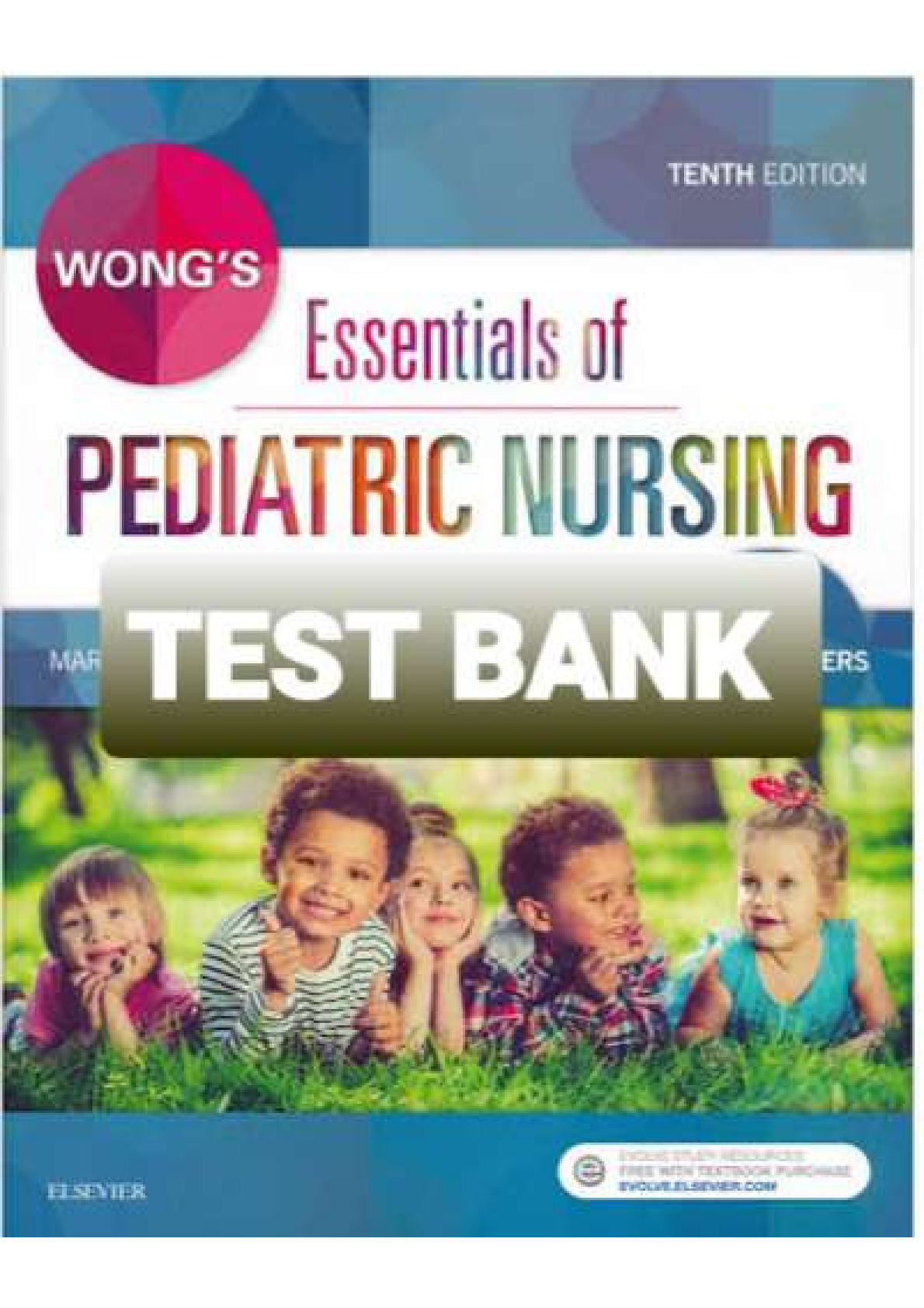
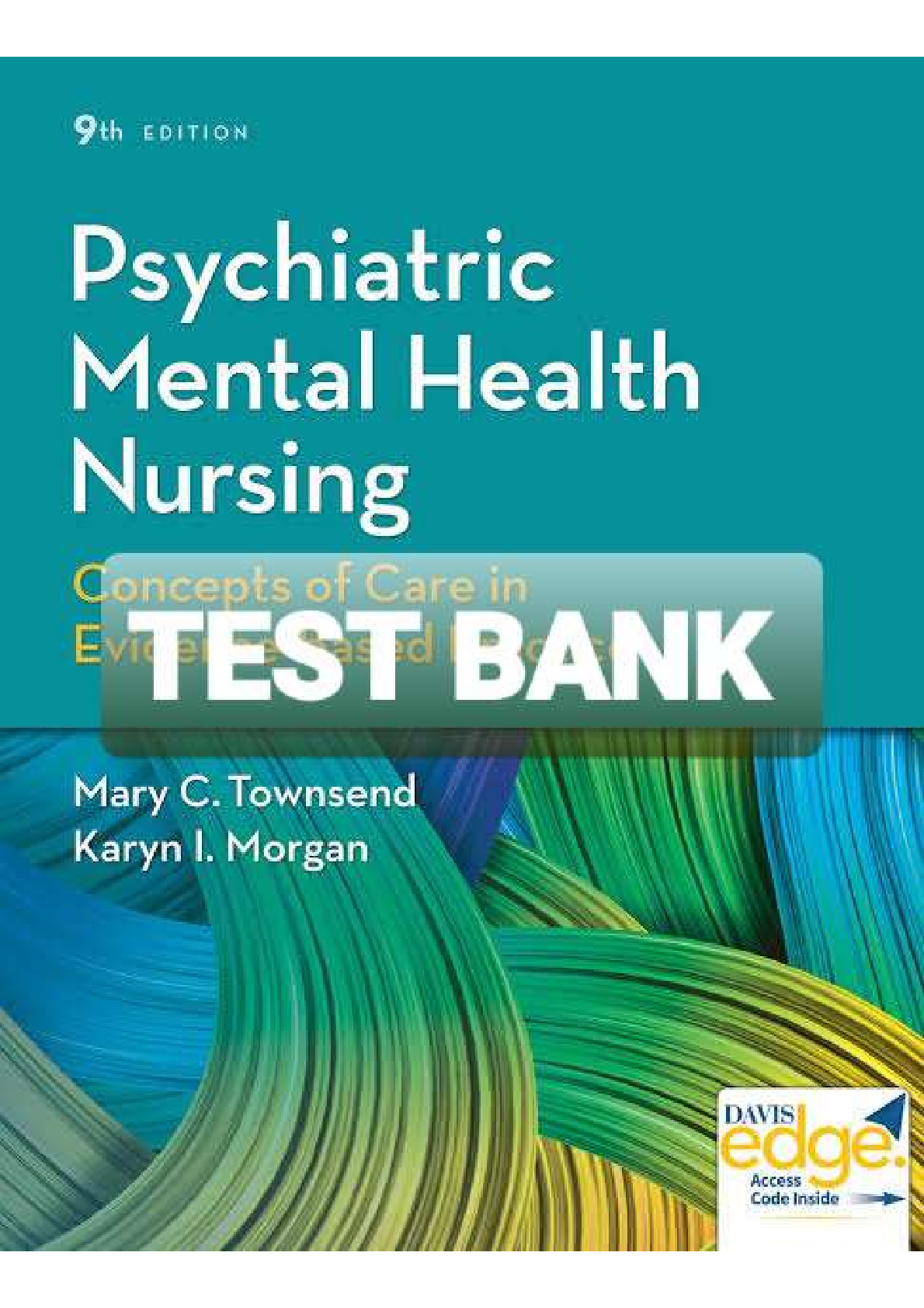
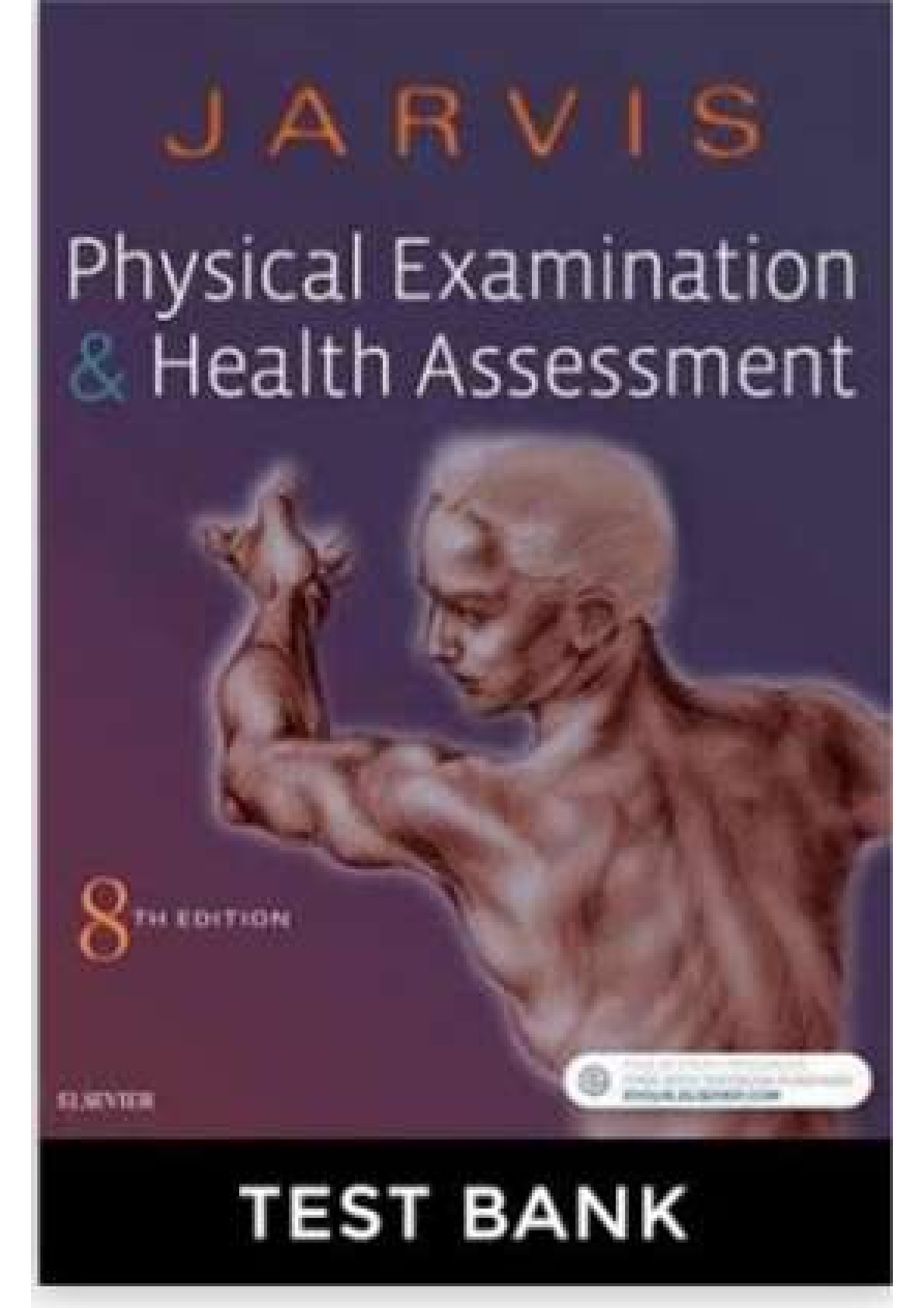
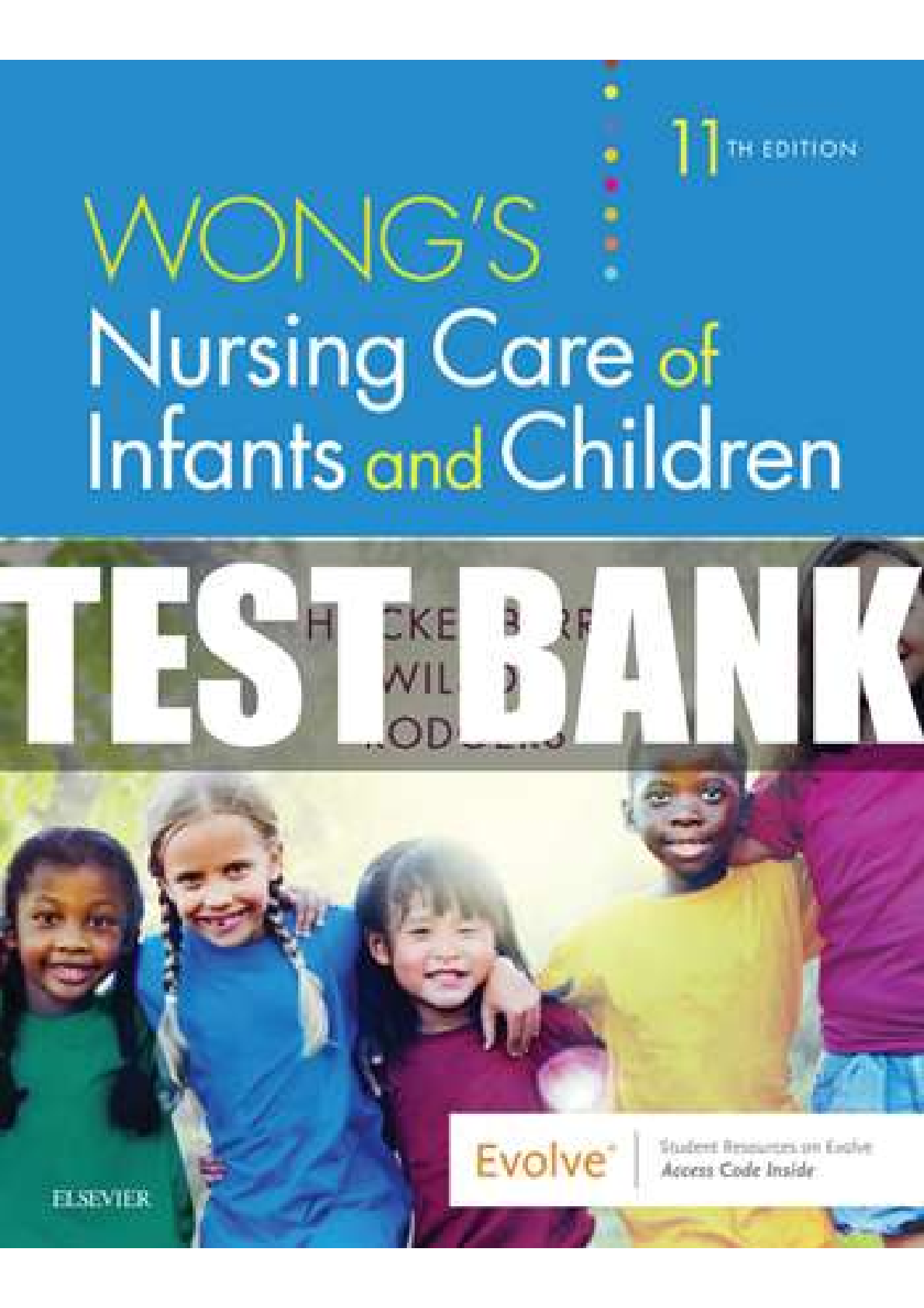
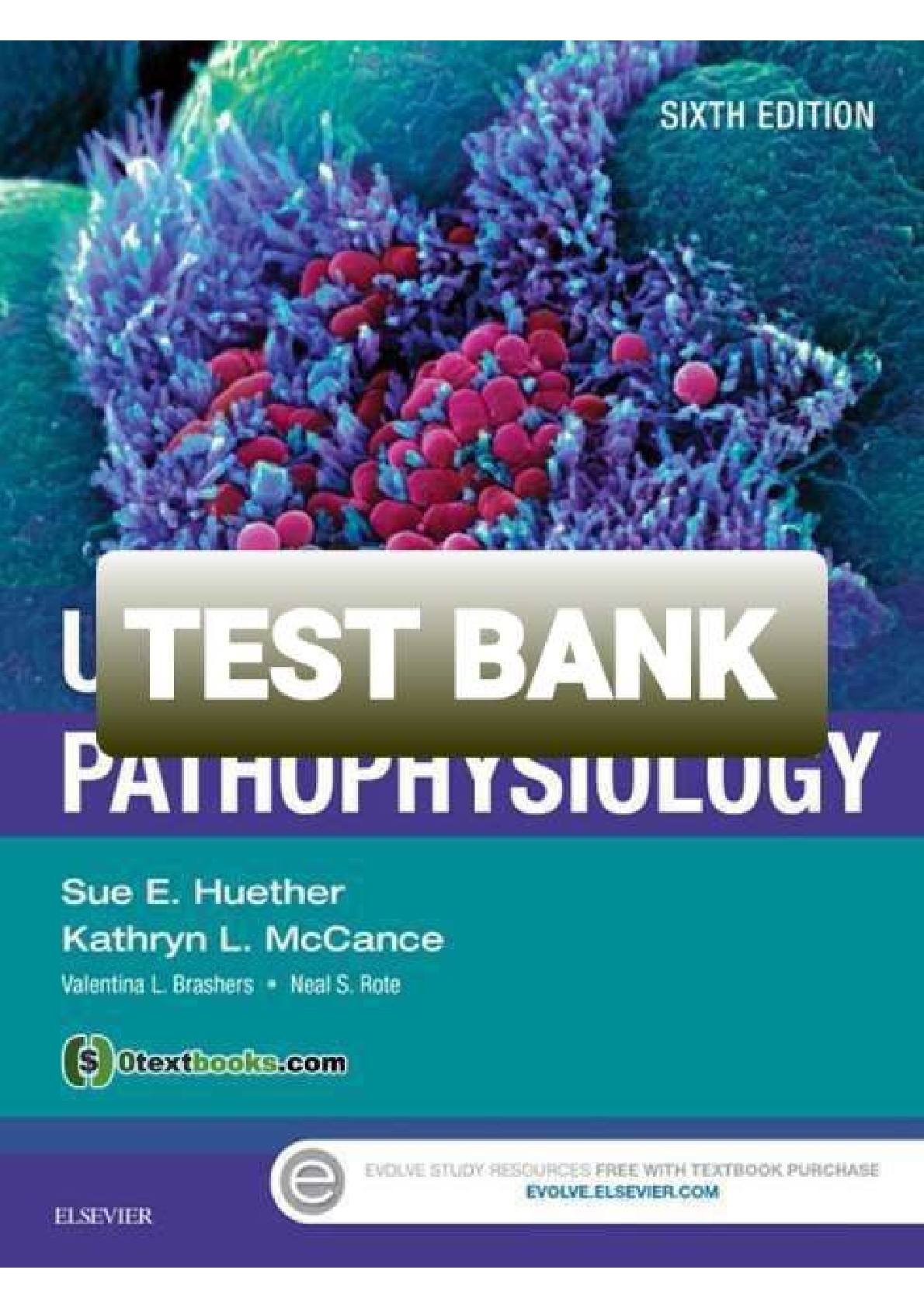
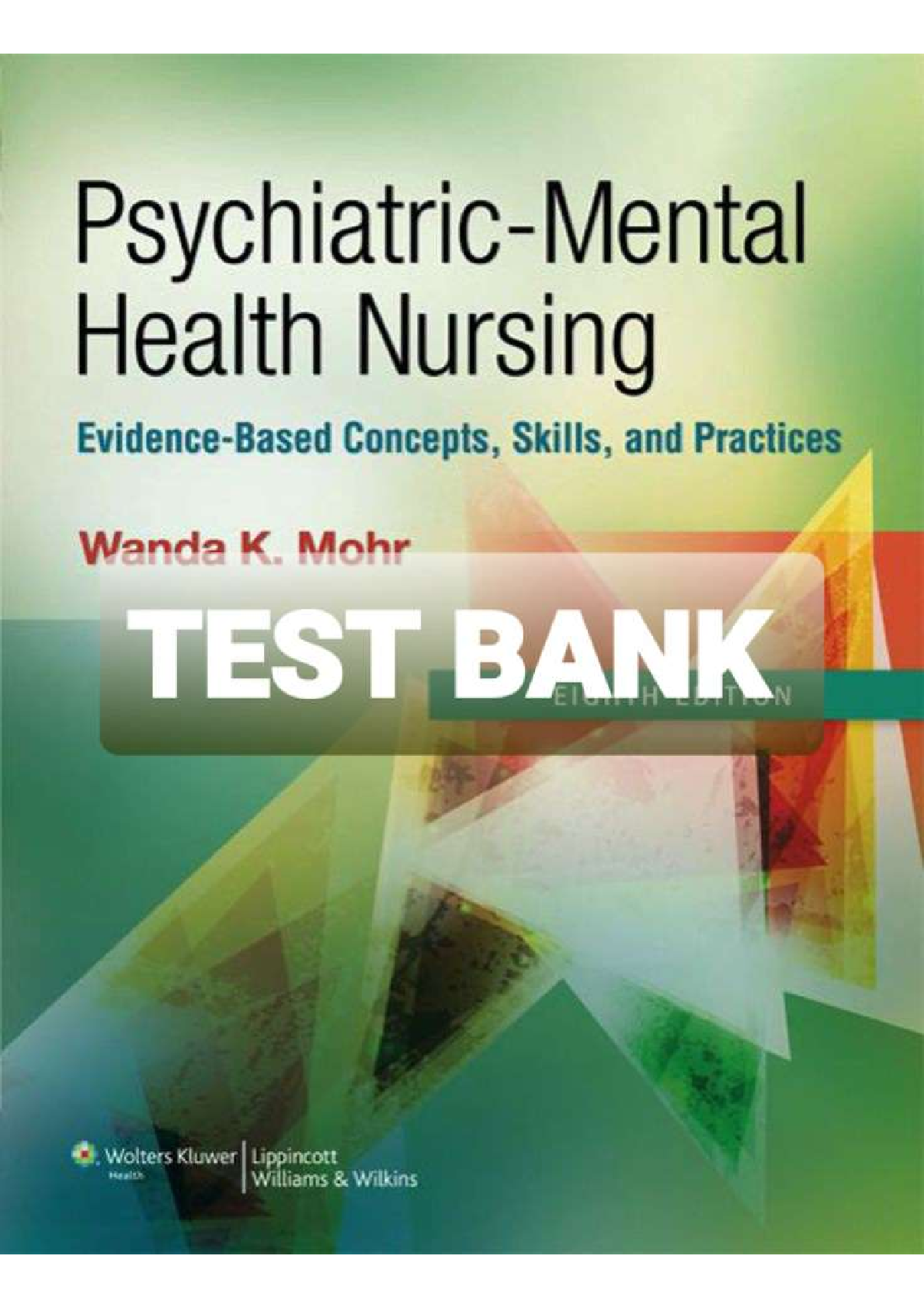
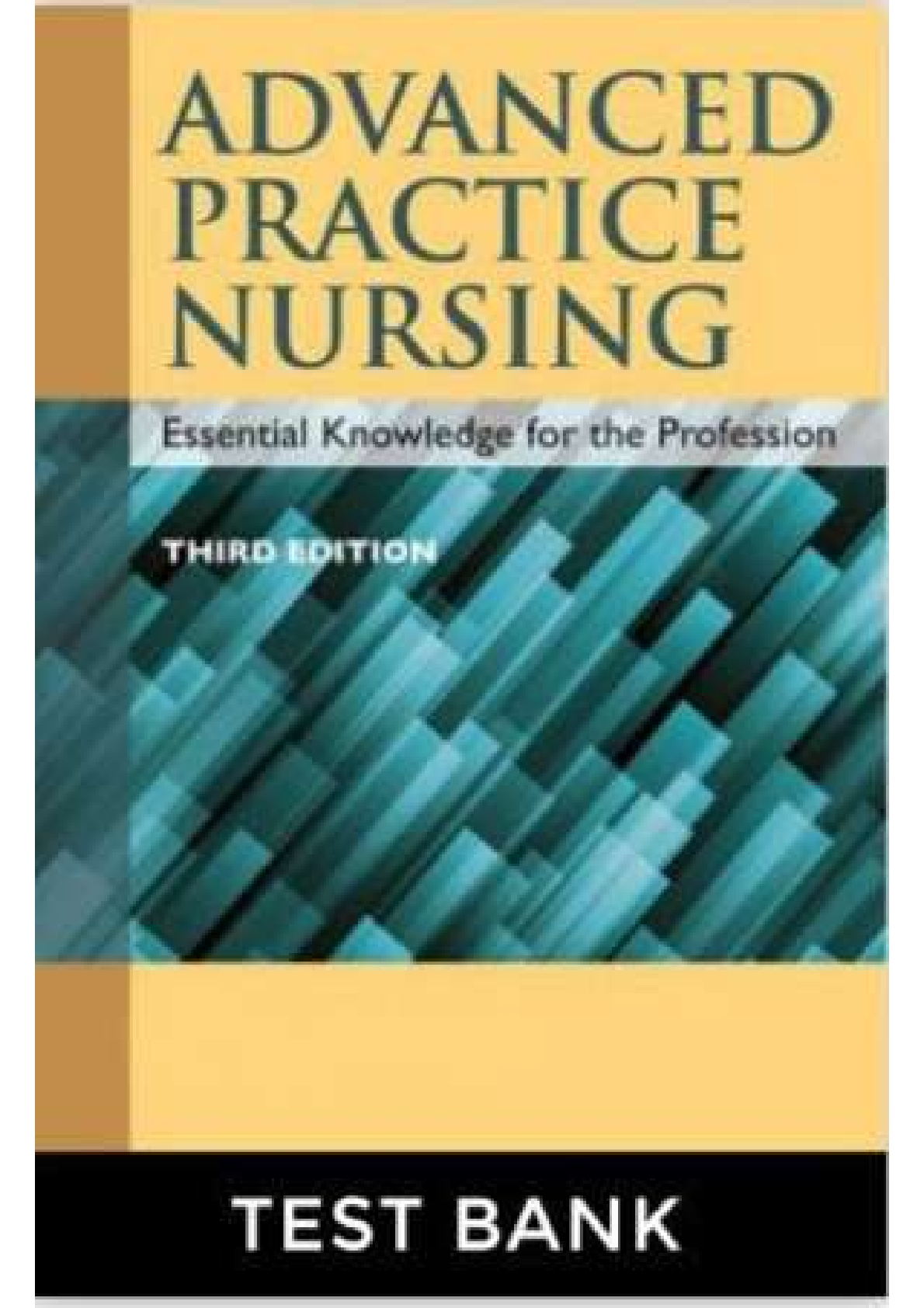

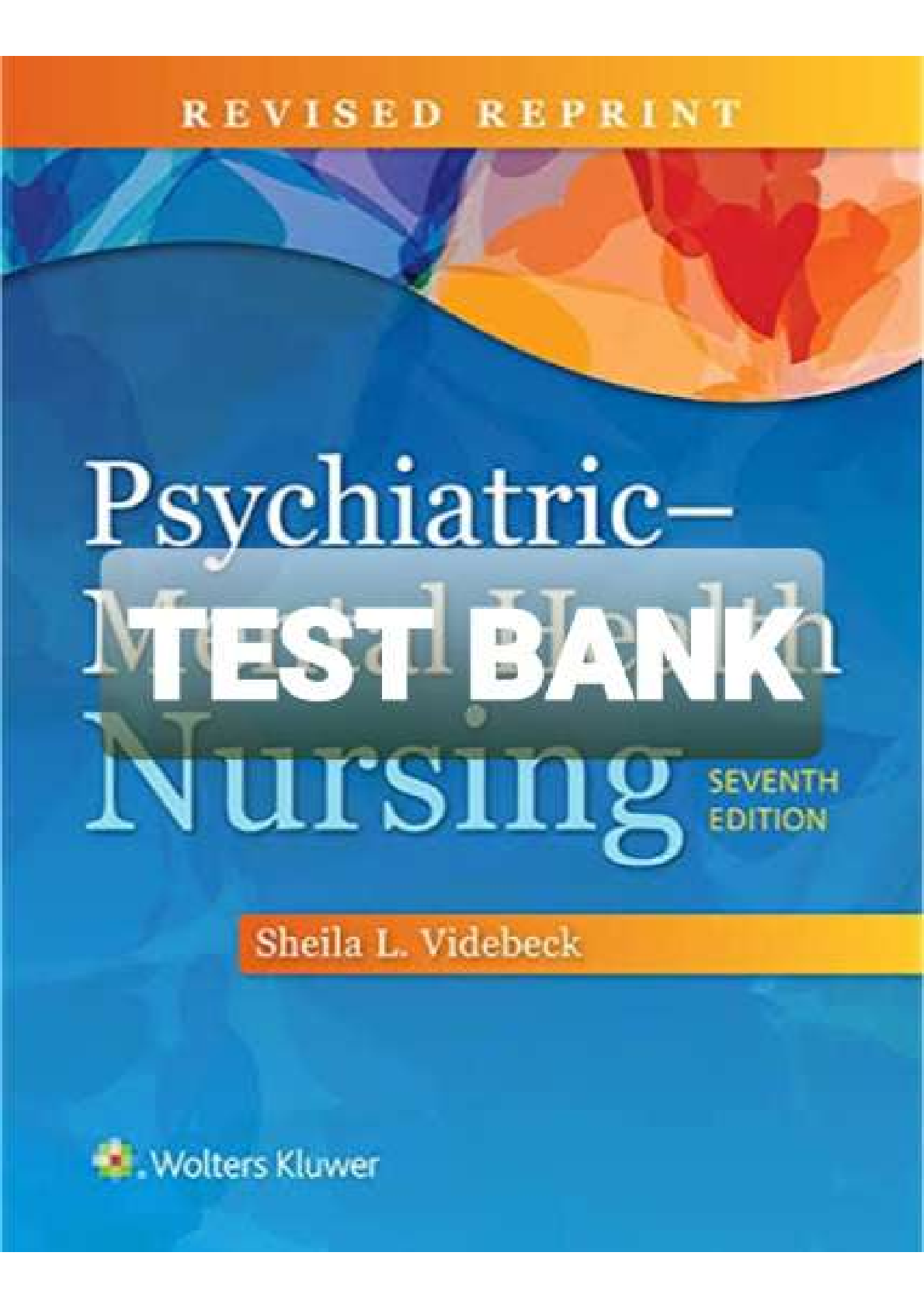

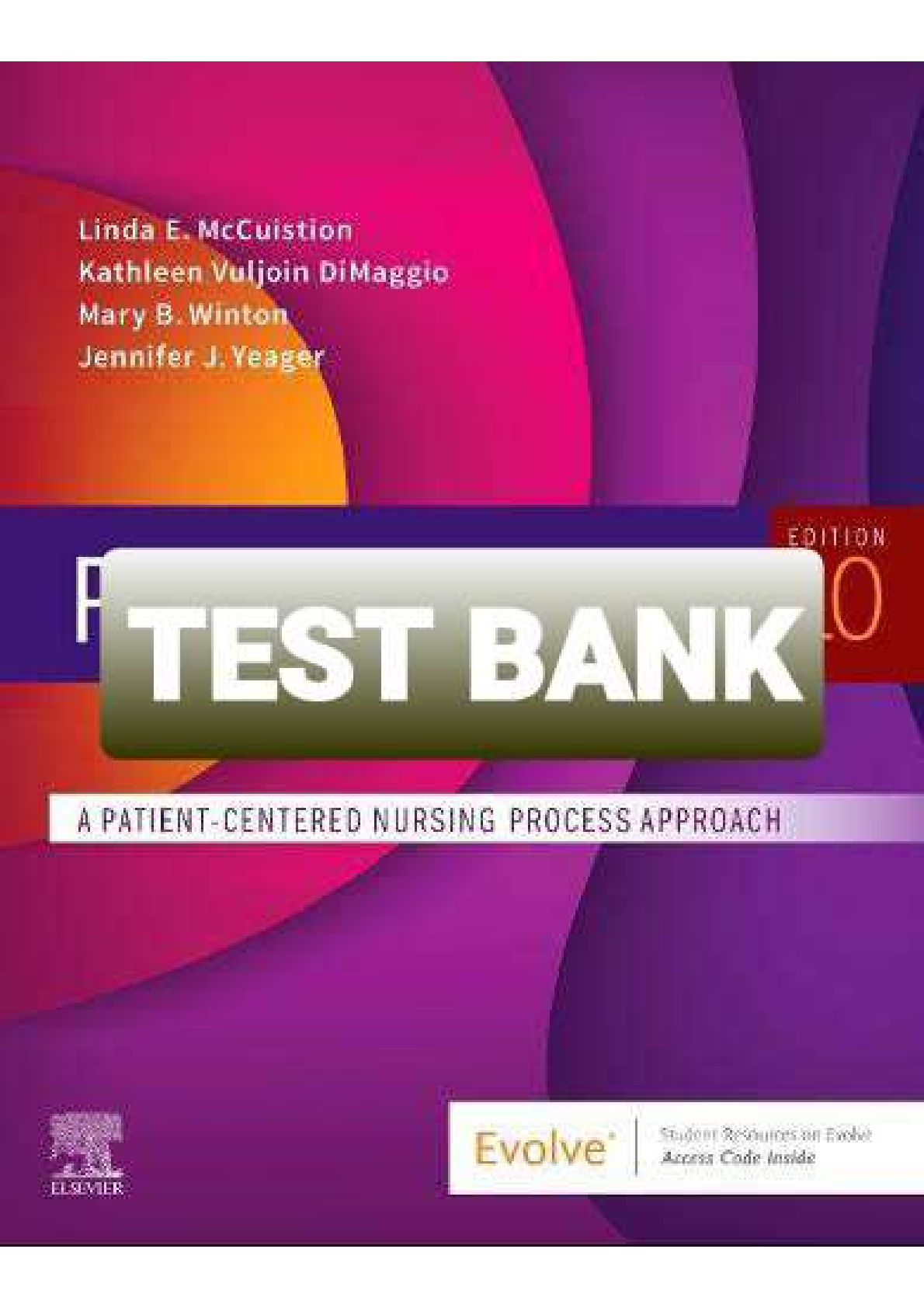
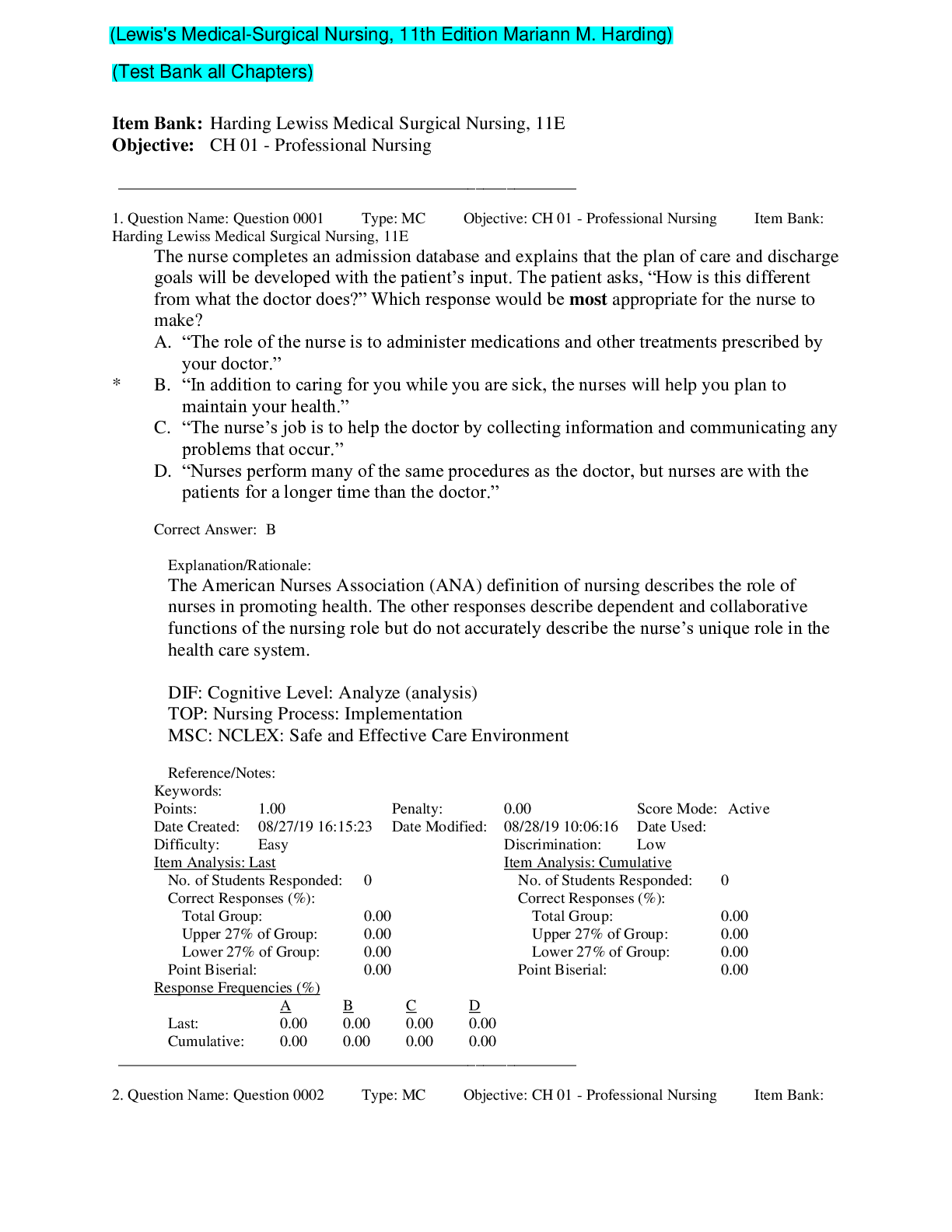
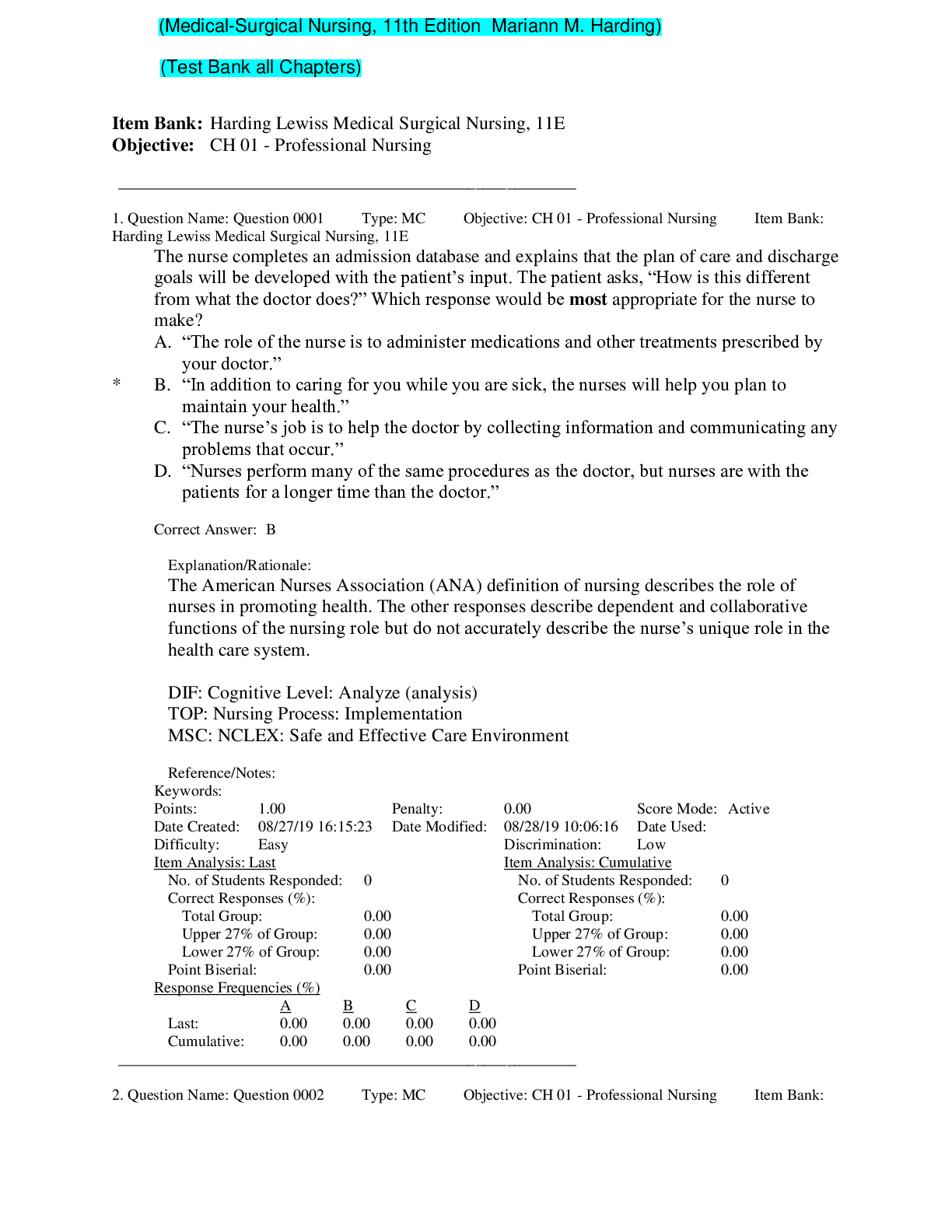
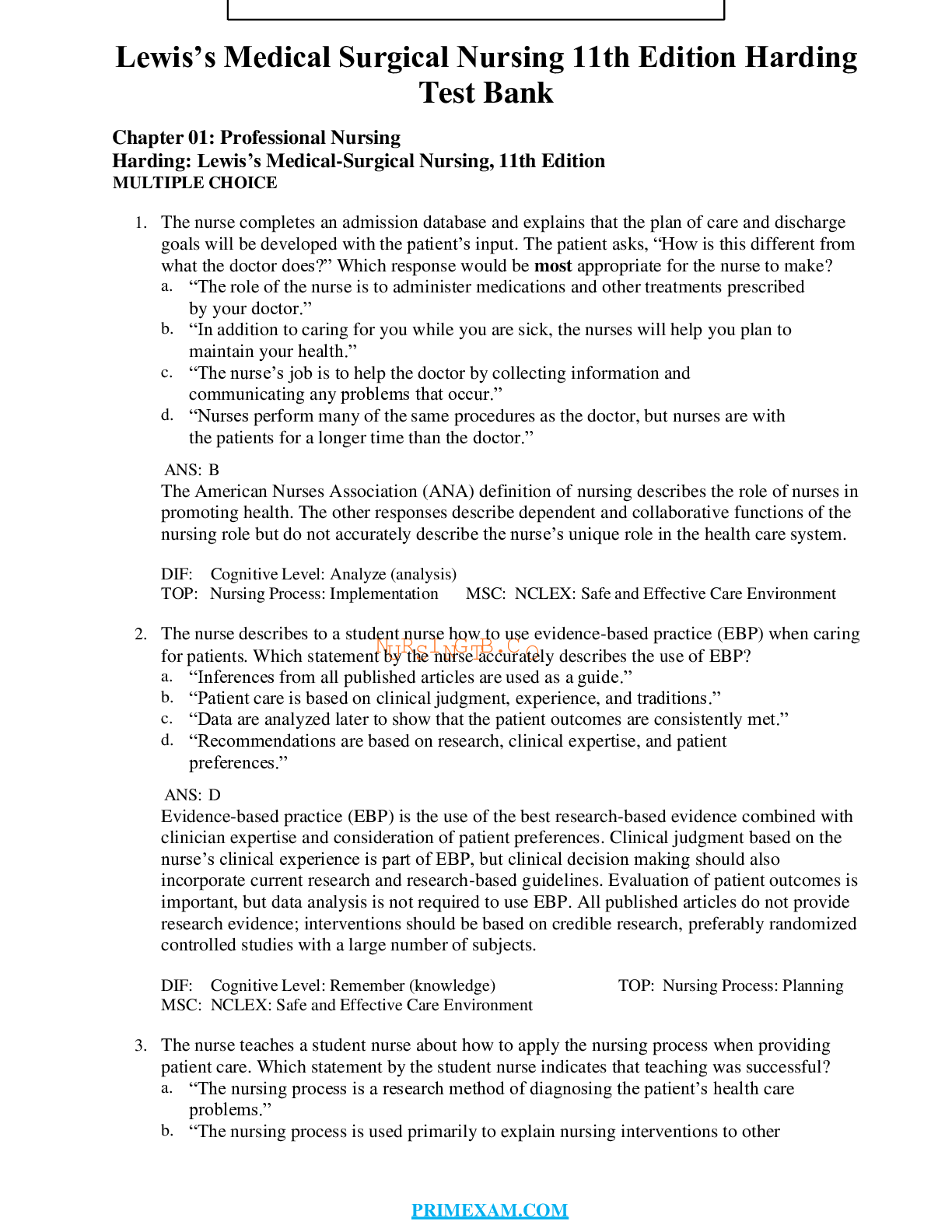
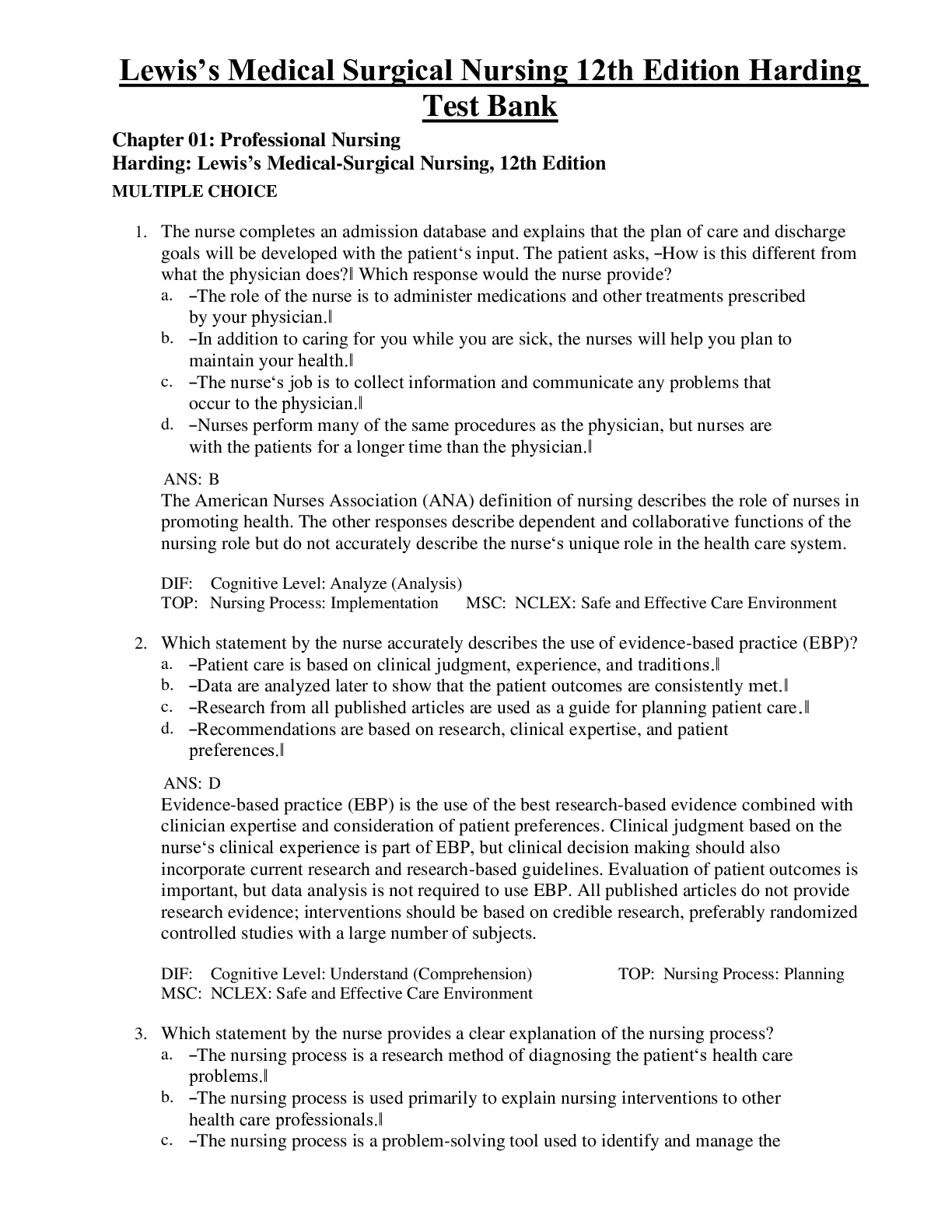


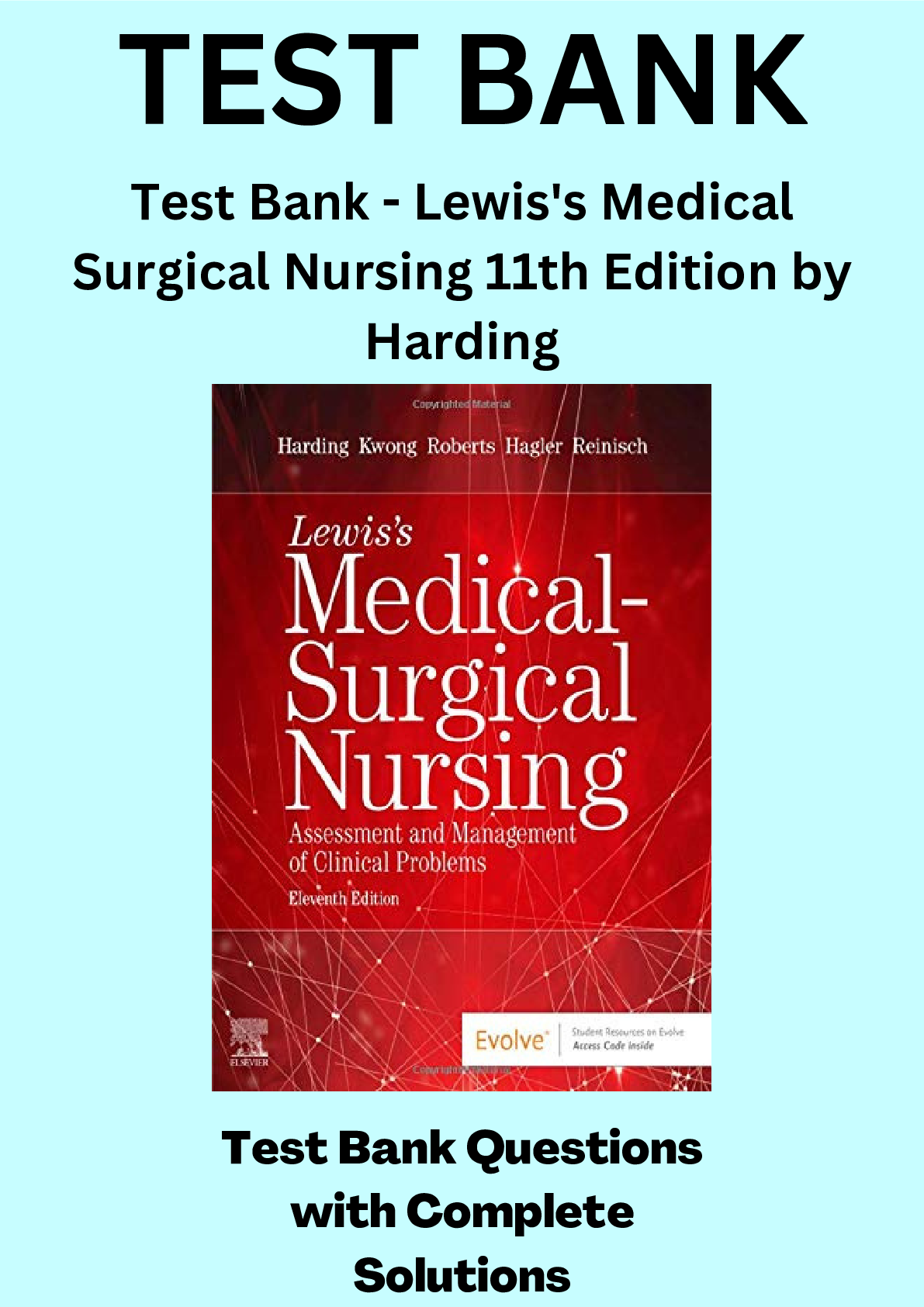
.png)
.png)

